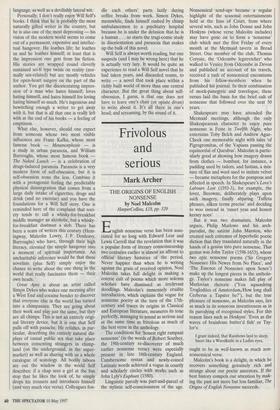Frivolous and serious
Mark Archer
THE ORIGINS OF ENGLISH NONSENSE by Noel Malcolm HarperCollins, £18, pp. 329 English nonsense verse has been asso- ciated for so long with Edward Lear and Lewis Carroll that the revelation that it was a popular form of literary connoisseurship two centuries earlier is almost an affront to official literary histories of the period. Never happier than when he is writing against the grain of received opinion, Noel Malcolm takes full delight in making a coterie cult of poems which more solemn scholars have dismissed as irrelevant doodlings. Malcolm's immensely erudite introduction, which explains the vogue for nonsense poetry at the turn of the 17th- century and traces its origins in Classical and European literature, measures its tone perfectly, managing to sound as serious and at the same time as frivolous as much of the best verse in the anthology.
The conditions for 'honest right rampant nonsense' (in the words of Robert Southey, the 19th-century re-discoverer of much earlier nonsense verse) were especially present in late 16th-century England. Cumbersome syntax and newly-coined Latinate words achieved a vogue in courtly and scholarly circles with works such as John Lyly's Euphues (1580).
Linguistic parody was part-and-parcel of the stylistic self-consciousness of the age. Nonsensical send-ups became a regular highlight of the seasonal entertainments held at the Inns of Court, from where several wits, such as John Donne and John Hoskyns (whose verse Malcolm includes) may have gone on to form a 'nonsense' club which met the first Friday of every month at the Mermaid tavern in Bread Street. One member of the club, Thomas Coryate, the `Odcombe legstretcher' who walked to Venice from Odcombe in Devon and published an account of his travels, received a rash of nonsensical encomiums from his fellow-members when he published his journal. In their combination of mock-panegyric and travelogue, these verses laid the basis for the brief cult of nonsense that followed over the next 50 years.
Shakespeare may have attended the Mermaid meetings, although the only Shakespearean character to enjoy pure nonsense is Feste in Twelfth Night, who entertains Toby Belch and Andrew Ague- Cheek one memorable night with tales 'of Pigrogromitus, of the Vapians passing the equinoctial of Queubus'. Malcolm is partic- ularly good at showing how imagery drawn from clothes — bombast, for instance, a padding used by tailors, and fustian, a mix- ture of flax and wool used to imitate velvet — became metaphors for the pompous and affected in speech. In Shakespeare's Love's Labours Lost (1593-3), for example, the lover, Berowne, deliberately plays upon such imagery, finally abjuring 'Taffeta phrases, silken terms precise' and deciding to woo instead in 'russet yeas and honest kersey noes'.
But it was two dramatists, Malcolm argues, Philip Marlowe and his arch- parodist, the satirist John Marston, who created such extremes of hyperbolic poetic diction that they translated naturally in the hands of a genius into pure nonsense. That genius was John Taylor (1598-1653), whose two epic nonsense poems ('Sir Gregory Nonsence His Newes from No Place', and 'The Essence of Nonsence upon Sence') make up the longest pieces in the antholo- gy. Taylor's nonsense makes full play of Marlovian rhetoric (`You squandring Troglodites of Amsterdam,/How long shall Cerberus a Tapster be?'), but the true pleasure of nonsense, as Malcolm says, lies as much in its sonorous inventiveness as in its parodying of recognised styles. For this reason lines such as Hoskyns"Even as the waves of brainlesse butter'd fish' or Tay- lor's: I grant indeed, that Rainbows layd to sleep, Snort like a Woodknife in a Ladies eyes, ought to be as well-known as much non- nonsensical verse.
Malcolm's book is a delight, in which he recovers something genuinely rich and strange about our poetic ancestors. If the best history compels our attention by mak- ing the past not more but less familiar, The Origins of English Nonsense succeeds.


































































 Previous page
Previous page